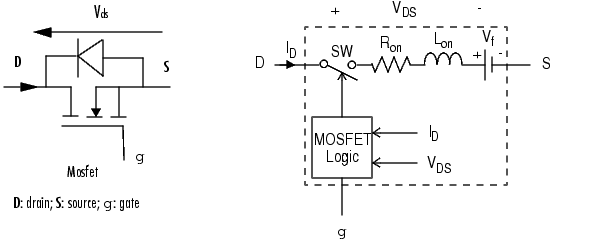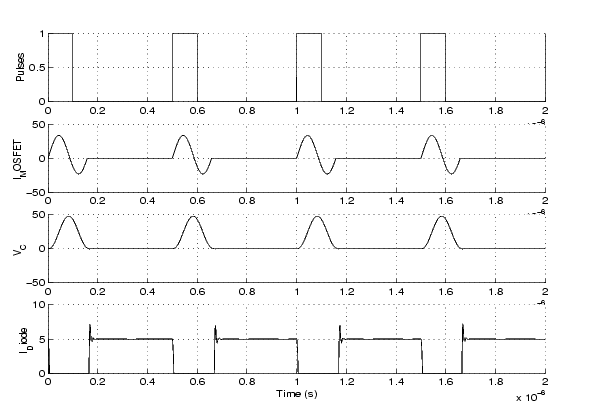

| Power System Blockset |   |
Library
Description
The Metal-Oxide-Semiconductor-Field-Effect-Transistor (MOSFET) is a semiconductor device controllable by the gate signal (g > 0) if its current Id is positive (Id>0). The MOSFET device is connected in parallel with an internal diode which turns on when the MOSFET device is reverse biased (Vds < 0). The model is simulated as a series combination of a variable resistor (Rt) and inductor (Lon) in series with a switch controlled by a logical signal (G>0 or g=0).

The MOSFET device turns on when the drain-source voltage is positive and a positive signal is applied at the gate input (g >0).
With a positive current flowing through the device, the MOSFET turns off when the gate input becomes zero. If the current Id is negative (Id flowing in the internal diode) and without a gate signal (g = 0), the MOSFET turns off when the current Id becomes zero (Id = 0).
Note that the on-state resistance Rt depends on the drain current direction:
The MOSFET block also contains a series Rs-Cs snubber circuit that can be connected in parallel with the MOSFET.
Dialog Box and Parameters
 ).
). 0. ).
). ). Set the Snubber resistance Rs parameter to
). Set the Snubber resistance Rs parameter to inf to eliminate the snubber from the model. 0 to eliminate the snubber, or to inf to get a purely resistive snubber.Inputs and Outputs
The first input and output are the MOSFET connections to drain (d) and source (s). The second input is a logical Simulink signal applied to the gate. The second output is a Simulink measurement vector [Id, Vds] returning the MOSFET device current and voltage.
Assumptions and Limitations
The MOSFET block implements a macro-model of the real MOSFET device. It does not take into account either the geometry of the device or the complex physical processes [1].
The MOSFET block is modeled as a nonlinear element interfaced with the linear circuit as shown on the next figure.
Therefore, in order to avoid an algebraic loop, the inductance Lon cannot be set to zero. The MOSFET block adds an extra state to the electrical circuit model. As the Mosfet is modeled as a current source, it cannot be connected in series with an inductor, a current source, or an open circuit, unless its snubber circuit is used.
Circuits containing individual MOSFET blocks cannot be discretized. However discretization is permitted for MOSFET/Diodes bridges simulated with the Universal Bridge block.
You must use a stiff integrator algorithm to simulate circuits containing MOSFETs. Ode23tb or Ode15s with default parameters usually gives best simulation speed.
Example
The following example illustrates the use of the MOSFET block in a zero-current-quasi-resonant switch converter. In such a converter, the current produced by the Lr-Cr resonant circuit flows through the MOSFET and internal diode. The negative current flows through the internal diode that turns off at zero current [1]. The switching frequency is 2 MHz and the pulse width is 72 degrees (duty cycle: 20%). This example is available in the psbmosconv.mdl file.
Run the simulation and observe the gate pulse signal, the MOSFET current, the capacitor voltage and the diode current on the four trace scope block. Also observe the state-plane trajectory (inductor current versus capacitor voltage).
References
[1] Mohan N., Power Electronic, Converters, Applications and Design, John Wiley & Sons, Inc., New York, 1995.
See Also
Diode, GTO, Ideal Switch, Thyristor
 | Linear Transformer | Multimeter |  |